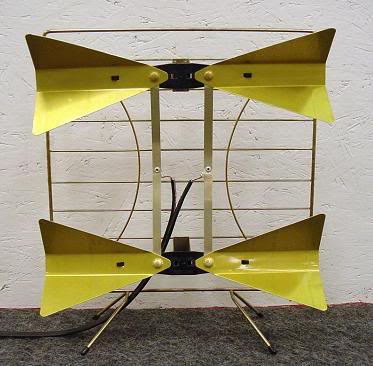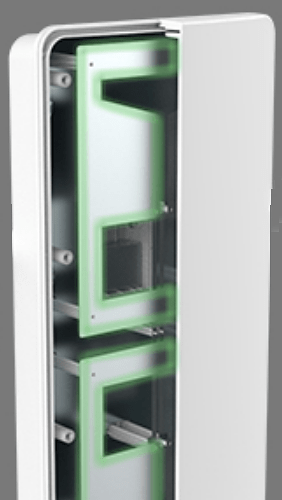It’s like… $143 anywhere I’d actually buy it from. They did $125, free shipping, no tax.
The 400BV will beat any Mohus hands down. My brother has one and two other friends. His is in the attic. I’d get one but I build my own antennas customized for my difficult OTA situation. If those ever give up the ghost, it’s Antop immediately. I use Antop’s Smartpass preamp (which they use on the 400BV) with one of my antennas and it’s pretty good for the price.
I bought mine on Amazon. They gave an $8 coupon, so it was $137 with Prime shipping.
But you got a great deal right from the manufacturer.
BTW, anyone who wants to save a few bucks just call Antop with questions about whatever antenna you want and they will offer a deal. You do not even have to bring that up.
I’ve taken one apart to look at the design. Read some articles also on this type of antenna. Seen also inside its precursors (from the same corporation). Intriguing enough to try and make one myself. All the materials plus wiring would cost around $30 (excluding the case). If it works, I might have to consider what to use for casing in case I decide to try it outside. I like their enclosure.
@MarkKindle Is there a link to a technical explanation of how this style of antenna works? I am not super technical but curious of how these flat shaped antennas perform as well or better than the old style Yagi ones.
I first encountered the “Antop” type antenna a few years ago. It was manufactured by the Qiaohua\Shenzen company and sold through different distributors under different brand names. The “Eaglestar” brand was the first I came across 6 years ago.
At that time it was a a “slotted waveguide” design used in cellphone tower antennas, More on this antenna type here:
http://www.antenna-theory.com/antennas/aperture/slottedWaveguide.php
Here is the Eaglestar inside:

The plate(s) are the receiving element(s).
Inside the Antop 400-BV:
The two 400-BV plates are the receiving elements: rectangular, flat figure-eight UHF dipoles. The total effective metallic antenna surface area is twice that of any flat, paper-thin antennas. If one measures the three lengths of the portruding sides, they come out to be 8 inches - the same as the Channel Master 4 and 8 bay antenna elements. This is the average UHF wavelength.
The added gain comes from the fact that these are plates, not rods, thus giving the antenna a bigger surface area for reception. Originally the ARRL bible for antenna design measured gain across full plated (not rodlike) antennas such as this Radio Shack:

As with the Eaglestar and Antop, the receiving elements don’t have to be large. Just sufficient for reception and amplification (their Smartpass preamp is good).
The Antop longitudinal shape (the dipoles are stacked column-wise) gives it a wider beamwidth and sweep than antenna arrays stacked row-wise.
The compact design makes it easily mountable unlike a yagi and placeable within an aesthetically pleasing case. Also the monolithic design of the dipoles (they aren’t an assemblage of separate receiving elements like in a CM 4 bay) gives it added stability.
The great Channel Master 4251 antenna uses the above RS butterfly receivers getting most of its gain from the reflector which pushes the signal onto the four elements.
Of course a lot of this is speculation on my part having looked at the interior design without having the actual engineering specs.
PS The Marathon antenna which people like is of this type.
@MarkKindle Thanks for the additional information. Antennas seem outwardly simple, yet have a lot of science in their bones!
That’s why I’m looking forward to the impact of ATSC 3.0 on antenna reception and design.
Besides various antenna companies implying you would need a new antenna for ATSC 3.0, would you really need one?
You might need a smaller one because the signal penetrates better or carries farther. The various stations will be using already assigned channel frequencies. It’s up to the tuner and demodulator to perform the magic.
I agree - new antenna not needed. In fact I expect my current antenna(s) to be 20 to 30% more efficient as far as the tuner is concerned. Same RF for 1.0 and 3.0.
There are some antenna companies already advertising their antennas as “ATSC 3.0 ready.” LOL
I thought I read a recent article implying that during testing in big cities with tall buildings with concrete canyons the signal penetration wasn’t up to expectation and translators might be needed.
This is a tricky situation. I saw one test in which someone got the signals perfectly while driving around in a car for thirty miles for about half an hour. But then someone stationary had trouble with some signals notably VHF. It appears their testing thus far has been geared towards mobile users.
My 400BV won’t be here until probably Monday. Meanwhile I printed a list of channels my TV scanned and then noted signal strength and SNR as reported by the TV as well as direction and distance. Signal strength is basically a 1 to 10 scale, but SNR is out to 2 decimal places and updates in real time.
Now I feel like I’ll have something to compare the 400BV against.
Where are you going to mount the AT-400?
For initial test I’m going to mount it on the mast where the Clearstream 4 is. So it’ll be mounted in the same location and connected to the same RG6 quad shield. For the first test, I’ll remove the 4-way distribution amp and just run it through a 4-way splitter with the 400BV’s amplification off.
From the result of that, I’ll decide if I need to do more in which case the second test will be to turn on the amplification. After that I’ll try with the distribution amp in place if I think I can do it without overdriving tuners anywhere.
I’m afraid, because of the MUCH wider beamwidth on the 400BV, that if I amplify, I’ll overdrive tuners when selecting the stations that are only 8 miles away.
Right now I’m aimed at the distant towers with the CS4, so those close ones are almost at the point of being lost. And I’m pre-amped at the antenna and also running through the distribution amp. I have about 75 feet of cable from the antenna to the distribution amp.
My hope is that I can aim the 400BV at those distant towers and pick up the close ones without overdriving, AND possibly pick up some of the Canadian stations off the backside
Received the 400-BV yesterday. Got it mounted right below the Clearstream4.
The weather will let me get up there and make some adjustments, but so far I’m happy.
In terms of signal strength, there is very little difference. In fact some stations are a tiny bit better with the CS4 and some are a tiny bit better with the 400-BV.
The REAL difference for me is that the wider beam width on the 400-BV means I can aim more or less down the middle of the 45 degree spread I have for tower locations and everything comes in strong with SNR in the 28 to 31 range.
I lost some Canadian stations that were barely lockable off the backside of the CS4. The 400-BV rejects them pretty much entirely. They’re about 45 miles away in the complete opposite direction that the antenna is facing. Not a big deal. Would have been nice, but definitely not a deal breaker.
I am a bit… concerned?.. about the power inserter on the 400-BV. The cabling is so wimpy. I mean, I have all of this RG6 quad shield run throughout and then I stick this power inserter into the setup and it looks like I’ve connected a garden hose to a fire hose. I might see if I can change the location of the inserter. I just have to make sure my distribution amp will pass the power. Pretty sure it does but will read the manual on it first.
So… I think success. I think the CS4 will come down and be replaced permanently by the 400-BV.
I’ll be better prepared to make that decision later today I hope.
You could aim the CS4 at the Canadian stations and combine it with the Antop.
The actual power inserter itself should be inside the house, not outside. Is that where you have it?
Yes, it’s inside. ![]()
It just has REALLY thin cable connecting to the coax.
When the amplifiers\power inserters come with a coax, it is usually RG59 (thinner than RG6).
